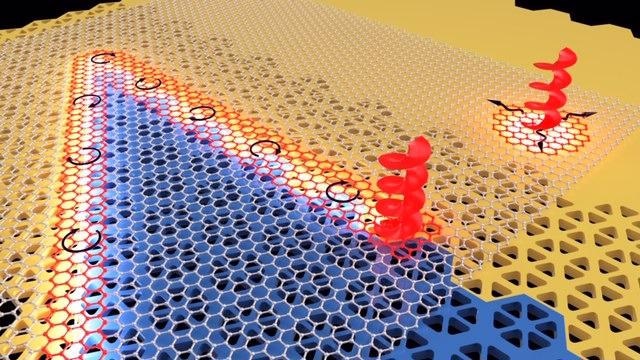In a new study by researchers from the City College of New York (CCNY), a novel method to unite two different states of matter has been reported. Topological photons — light — have been joined for the first time with lattice vibrations, also called phonons, to exploit their propagation in a strong and regulated fashion.
 Topologically distinct photonic crystals (orange and blue) with a layer of hexagonal boron nitride on top. Image Credit: Filipp Komissarenko and Sriram Guddala.
Topologically distinct photonic crystals (orange and blue) with a layer of hexagonal boron nitride on top. Image Credit: Filipp Komissarenko and Sriram Guddala.
The researchers made use of topological photonics, an upcoming direction in photonics that utilizes central concepts of the mathematical field of topology regarding conserved quantities — topological invariants — that remain constant when modifying parts of a geometric object under constant deformations.
One of the most basic instances of such invariants is the number of holes, which, for example, makes donut and mug equivalent from the topological standpoint. The topological features give photons helicity when photons spin as they spread, creating unique and surprising features, such as robustness to flaws and unidirectional propagation along the interfaces between topologically unique materials.
Owing to the interactions with vibrations in crystals, these helical photons can subsequently be employed to channel infrared light together with vibrations.
The impact of this study is wide-ranging, particularly enabling scientists to advance Raman spectroscopy, which is used to establish vibrational modes of molecules. The study is also quite promising for vibrational spectroscopy — also called infrared spectroscopy — which measures the interaction of infrared radiation with matter via emission, absorption, or reflection. This can then be employed to analyze and identify and define chemical substances.
We coupled helical photons with lattice vibrations in hexagonal boron nitride, creating a new hybrid matter referred to as phonon-polaritons. It is half light and half vibrations. Since infrared light and lattice vibrations are associated with heat, we created new channels for propagation of light and heat together. Typically, lattice vibrations are very hard to control, and guiding them around defects and sharp corners was impossible before.
Alexander Khanikaev, Lead Author and Physicist, Grove School of Engineering, CCNY
The new approach can also perform directional radiative heat transfer, a kind of energy transfer during which heat is dissipated via electromagnetic waves.
We can create channels of arbitrary shape for this form of hybrid light and matter excitations to be guided along within a two-dimensional material we created. This method also allows us to switch the direction of propagation of vibrations along these channels, forward or backward, simply by switching polarizations handedness of the incident laser beam.
Dr. Sriram Guddala, Postdoctoral Researcher and Study First Author, Prof. Khanikaev’s Group, CCNY
He added, “Interestingly, as the phonon-polaritons propagate, the vibrations also rotate along with the electric field. This is an entirely novel way of guiding and rotating lattice vibrations, which also makes them helical.”
The study titled “Topological phonon-polariton funneling in midinfrared metasurfaces” has been published in the journal Science.
Journal Reference:
Guddala, S., et al. (2021) Topological phonon-polariton funneling in midinfrared metasurfaces. Science. doi.org/10.1126/science.abj5488.